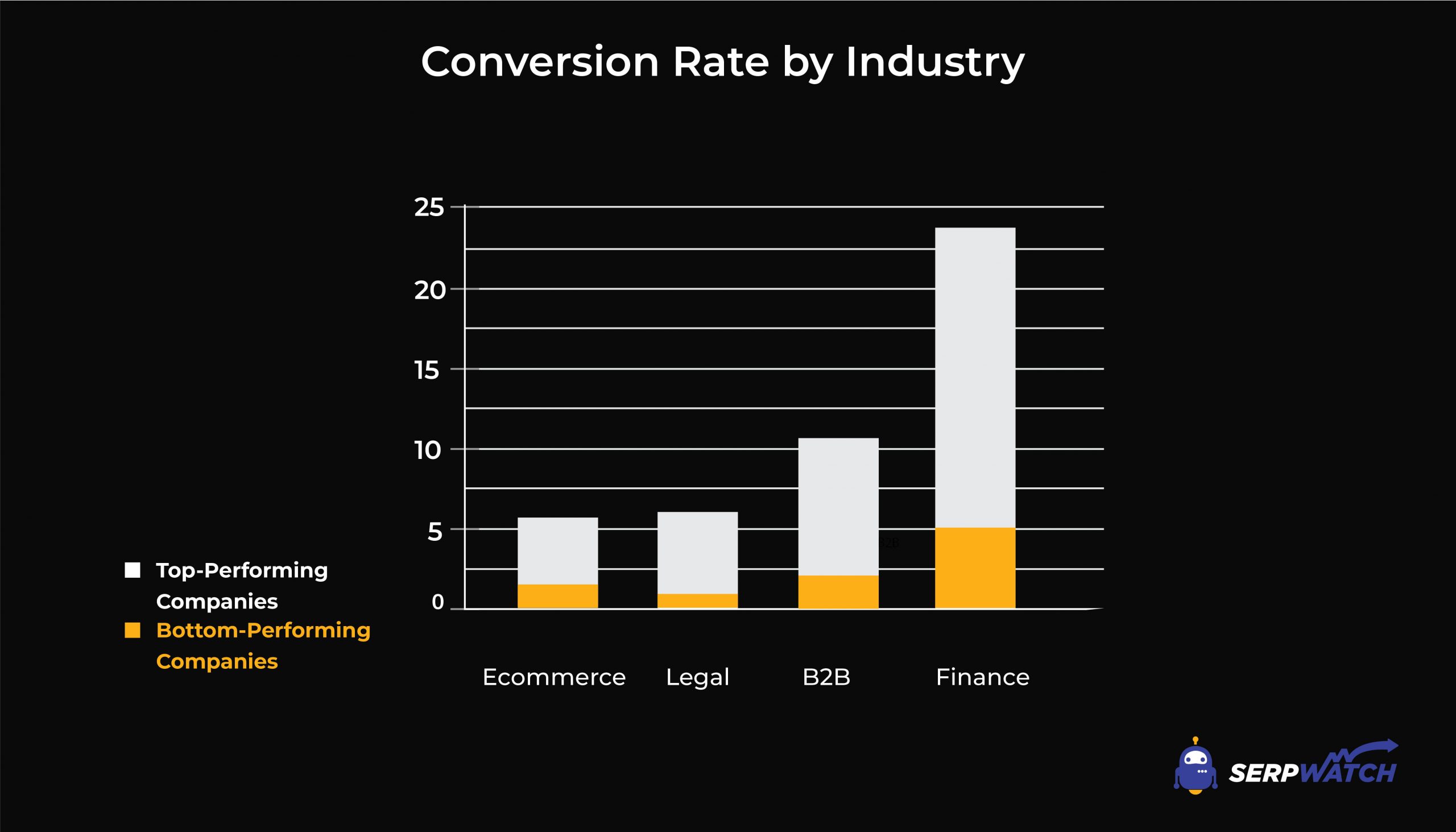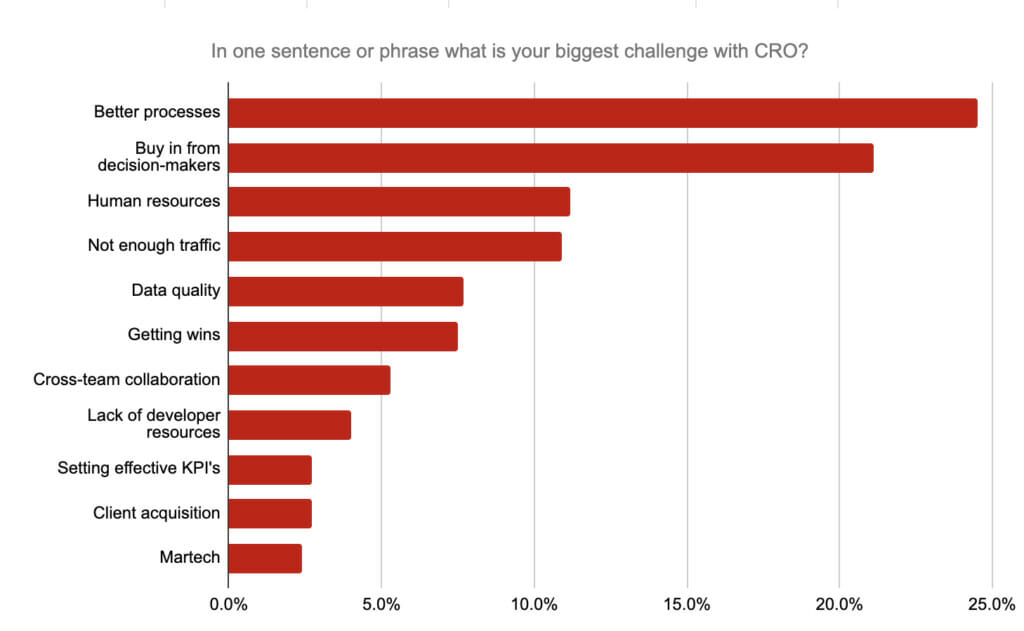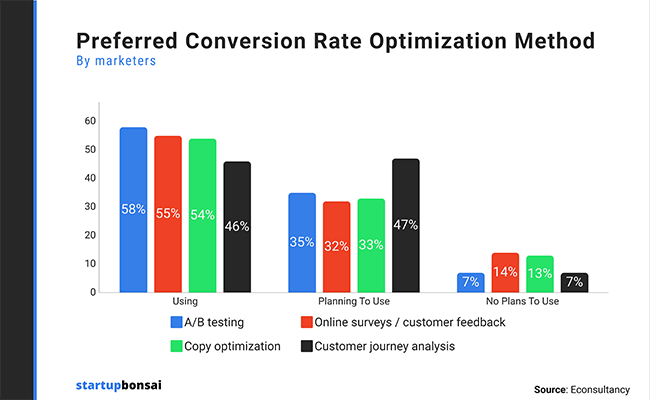When you're working toward long-term, sustainable growth for your brand, conversions are pretty high on your priority list. After all, without conversions, you won't get the revenue you need to propel you toward ongoing growth. And anyone who's been in marketing for more than a minute knows that conversions don't just happen on their own. There's no magic trick to make people click...but there are proven methods to improve your odds.
Enter conversion rate optimization or CRO. CRO involves all the work you do to nudge leads through your funnel and out the other side (the conversion side, that is). But depending on your industry, product, niche, audience, etc., there might be several tactics involved in CRO and several teams involved.
First, you need to understand that average conversion rates vary widely across industries.

So, a law firm is never going to convert at the same rate as a fintech service provider. And that's okay. By understanding your industry and standard conversion rates, you'll be able to set clear, achievable goals.
Now, onto the sticky subject at hand: whose responsibility is it to deal with CRO?
What Is CRO in Marketing?
We're marketers. And we love conversions. And we also love the challenge of optimizing marketing strategies to get more conversions. You can probably see where we're going with this.
To us, CRO is typically a function of marketing. But if you have a product team and/or a UX and design team, it's not always clear where CRO is or should be handled — that's because effective conversion optimization will touch numerous areas of your business. For example:
- Marketing is interested in converting more people coming through different channels they're investing in.
- Product should be invested in anything that's changing the website design or purchasing funnel.
- Design and UX is involved with any sort of testing or optimizations on the website to improve a customer's journey or user experience.
The end goal is the same for every team — convert more customers. But if your teams aren’t on the same page in utilizing that data and the changes needed to increase conversion, the whole thing falls apart. It doesn't help that, on the whole, CRO comes with its own unique set of challenges and barriers.

The same data as above also shows that CRO spending and prioritization has fallen over the last few years. Perhaps there's some confusion over which team is handling it, or perhaps it's a case of too many cooks in the kitchen.
But here's the deal: With excellent cross-team collaboration and communication, CRO can be a reliable and effective way to achieve long-term growth. No matter how you’re trying to connect with leads, CRO can help you create a platform that appeals to all segments of your demographic, regardless of when and how they navigate to your site.
In order to be successful, the conversion optimization process requires a strategic interaction of statistical methodologies and the clear goals you’ve set for your business. Effective optimization includes the following processes:
- Data Collection: In this stage, a CRO software runs tests for different variables on your site, checking for which variables have the highest successful conversion rates. A variety of tests can be used, including A/B testing and simple design changes. Usually, these changes are shown to a percentage of your site visitors, and the version that has the highest conversion is the "winner." Then these changes are then replicated to your website for all visitors. The simplicity and efficacy of A/B testing makes it the most common method of CRO.

- Goal Setting: This stage is where you compare the data with your specific goals, implementing the variables with the highest success rates.
- Real-time Implementation: Based on the goals you set and the specific results from the variables tests, the software provides the optimized versions of your site to the correct segment of your audience.
- Statistical Tracking: In this final stage of the process, statistics are tracked to give you proof of how the different versions of your site are performing, along with the ability to repeat your results.
Throughout these stages of the CRO process, team members from different departments of your organization will need to intervene to make changes to your site or adjust campaigns.
CRO Marketing and Team Engagement
Applying the insights you receive from the CRO process can be tricky when multiple teams are involved. But ultimately, the entire business will win when all teams are integrated and working together toward your goal.
Let’s take a look at the different ways the product team, marketing team, and design team will need to work together when optimizing your website for conversion:
CRO and the Product Team
The product team is probably the first department you’d think to involve in the CRO process because they are involved in building a relevant product (website, app, etc.) and the purchase funnel(s). If you're changing the website — how it looks and how it feels — then the product team cares.
Additionally, you will likely need developers (JavaScript, front-end, etc.) to help with certain test changes in the CRO platform you're using, so they need to be invested from a resources standpoint. This team should always be involved in a feedback loop if changes are required based on feedback from customers or other teams.
If your company provides product demos, the team will also need to work closely with marketing and design in order to optimize for different segments. The product team matters to conversion optimization.
CRO and the Marketing Team
Your marketing team is working hard to bring people to your website — whether that's through organic search engine optimization, PPC advertising, lead generation, or social media. Traffic matters, but revenue matters more.
Why?
Because of the BIG KAHUNA GOAL. If marketing kills it to bring in tons of traffic, but those visitors aren't converting, that's a problem. It might be a "qualified traffic" problem, but it's also a conversion problem.
When running certain tests, marketing will make sure all content is optimized for things like SEO, personas, customer journey/intent, brand voice, and business goals. They’ll likely provide multiple versions of content and copy to test on your site that appeals to different segments of your audience. They’ll also adjust marketing campaigns, create downloadable content, curate a variety of images, and tailor a call to action that sounds genuine to different demographics. The marketing team matters to conversion optimization.
CRO and the UX/Design Team
Without a team to think through how all of the content and code comes across via user experience in your product, then all of this will likely fail. Yes, you need nice buttons, images that are personalized, and copy that converts — but how does it all work together and look, and how does it all work with the rest of your site and look to the rest?
Your UX/design team will take the testing data and goals you’ve established throughout the CRO process and make it functional on your site so that a seamless customer journey is created. Because CRO is constantly evolving in the background, the design/UX team will need to stay informed on the changes that need to be made, as well as updated on what’s working. The UX/design team matters to conversion optimization.
Do You Need to Hire a CRO Expert?
If it takes three teams working together to successfully implement CRO, then how the heck do you hire a Conversion Optimization Expert? And what team is responsible for the internal processes of creating a job description, screening candidates, and interviewing? When they are hired, what team should they work with most closely or "belong to"?
Though the answers will ultimately depend on your unique product and demographic and might vary from business to business, it makes the most sense to us to assign the responsibility to a specialized member of the marketing team who collaborates closely with product and design.
But it won't come cheap (nor should it). An experienced CRO means you'll need to provide appropriate compensation.

Someone with 10+ years of experience (someone who is definitely going to move that conversion needle) will have a much higher price tag. Beyond that, they'll have to be ready to navigate the different teams who all have a stake in CRO — marketing, product, and UX/design.
If you're still stuck on how to fulfill this role at your company — we can help. At FPS, we have CRO experts who deliver proven results for our clients, and you get the benefit of their years of experience without making an internal hire. At the same time, they'll seamlessly integrate with and become an extension of your internal teams to help you achieve your conversion goals.






